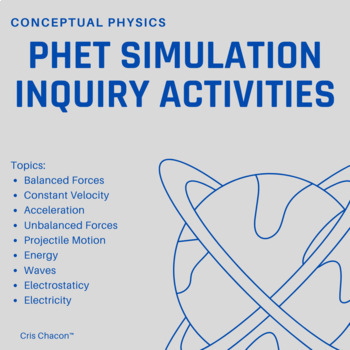01 - Density PhET Simulation Summary
- Google Docs™

Also included in
- 14 fully editable, NGSS/modeling pedagogy aligned PhET simulation lab summaries! Most PhET Simulation lab summaries consist of 2-3 pages, with space for students to provide a combination of the following information:Lab investigation purposeData for the independent and dependent variableWritten statPrice $80.00Original Price $84.00Save $4.00
- 21 fully editable, NGSS/modeling pedagogy aligned inquiry lab summaries & 11 lab challenges! Inquiry Labs:Most lab summaries consist of 2 pages total, with space for students to provide the following information:Lab investigation purposeData for the independent and dependent variableWritten statPrice $175.00Original Price $212.00Save $37.00
- *You can request sample previews of resources or units! Please email cris.chacon@knowlesteachers.org to request them. Additionally, upon purchase, please email cris.chacon@knowlesteachers.org to receive immediate access to all of these resources and more through Google Drive Folders and Documents.43Price $675.00Original Price $841.00Save $166.00
- 3 fully editable, NGSS/modeling pedagogy aligned worksheets, 4 inquiry labs, 3 lab challenges, 2 quizzes, 6 guided notes/reading assignments, 1 unit review, 1 writing assignment, 1 equation toolbox, and 1 curriculum guide!WorksheetsThere are a variety of free response questions for most worksheets,Price $60.00Original Price $76.00Save $16.00
- 17 fully editable, NGSS/modeling pedagogy aligned worksheets, 9 quizzes, 16 inquiry labs, 4 unit reviews, 4 unit tests, 7 lab challenges, 5 writing assignments, 5 concept builders, 5 equation toolboxes, 15 guided readings and notes, and 5 curriculum guides!WorksheetsThere are a variety of free respoPrice $350.00Original Price $427.00Save $77.00
Description
Fully editable, NGSS/modeling pedagogy aligned inquiry lab summaries! Most lab summaries consist of 2-3 pages, with space for students to provide the following information:
- Lab investigation purpose
- Data for the independent and dependent variable
- Written statement on data trends
- Sketch of a graphical model using a line of best fit
- Linear and quadratic equation to mathematically model the relationship between the variables
- Analysis of physical meanings of slope and y-intercepts
- Space to list tools used and a brief description of collecting and analyzing data
- Space to reflect on the validity of the data by discussing error and data methods
- Space for notes taken during whole class data discussions
If the lab summary is of a PhET Simulation, there are also questions embedded that highlight conceptual understanding of phenomena observed, requiring students to explain using vocabulary and observations, often in addition to mathematical analysis.
Inquiry labs are used for students to develop multiple representations of natural phenomena through planning and implementing lab investigations, collecting and analyzing data, and generating graphical, mathematical, and diagrammatically models. The models developed from inquiry labs can be refined through whole class Socratic discussion to generate reliable methods of analyzing physical phenomena and make meaningful predictions when given known variable values, such as Newton’s 2nd Law and Kinematic Equations.
Learning Targets Assessed:
I know...
- the definition of a dependent variable and an independent variable.
- whether an object will float or sink using the substance and object density.
I can...
- measure the mass, volume, or density of an object with enough information.
Sample solutions are available by purchasing the Conceptual Physics PhET Simulations Bundle.







